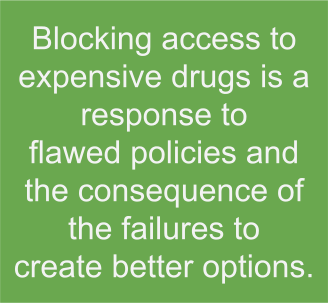The TPP, following a plethora of other trade agreements involving the United States, the European Union and Japan as trading partners, seeks to expand and extend drug monopolies, by requiring lower standards for the grant of patents, extensions of patent terms, exclusive rights in test data, among other measures. These proposals and polices are designed to have the predictable effect of making drug prices higher.
Governments and private reimbursement entities (including employer managed plans, and private insurance plans) respond to higher prices by restricting access, and placing higher financial burdens on patients and families. Access can be restricted in a variety of ways, such as through price sensitive formularies, narrow approved uses, and higher patient co-payments, or even a complete unwillingness to reimburse the product at all (such as for the effective breast cancer drug T-DM1 in Northern Ireland, Wales and Scotland).
In our view, policy needs a reboot. Put the patents at risk, not the patients. When prices are too high, use compulsory licenses to end monopolies. Make the expensive drugs less expensive, don’t use the patients as hostages.
And, if people think lower prices lead to lower R&D investments, and are concerned about this, there are plenty of options that don’t put patients at risk. Governments can mandate higher R&D investments or contributions to R&D funds from companies selling drugs (as DHHS did with cisplatin sales), increase government R&D spending, or implement full delinkage of R&D costs from drug prices. All of these provide mechanisms to enhance R&D spending without putting at risk the patient’s access to a useful drug or vaccine.
In 2015, it should not be so so hard to tell patent owners they will lose a monopoly, or so easy to tell patients a drug is not reimbursed.
